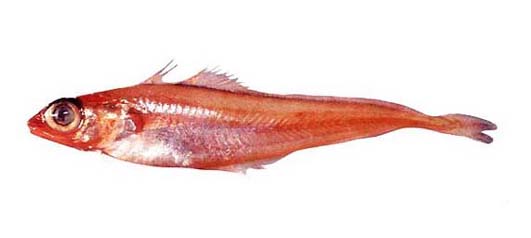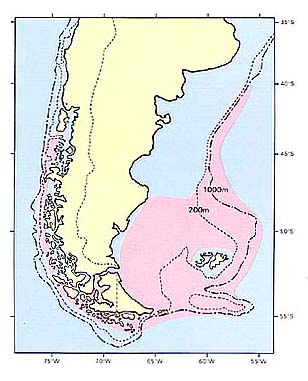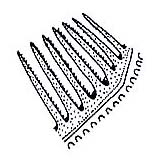チゴダラ科
- HOME
- デジタル図鑑
- パタゴニア海域の重要水族
- 硬骨魚綱 タラ目
- チゴダラ科
チゴダラ科(Moridae)

26 ヒメアカダラ(Hime-akadara)
Austrophycis marginata (Günther, 1878)
Brotola (Arg.)
特 徴:
第1背鰭8~9軟条,第2背鰭57~62軟条,臀鰭52~56軟条,胸鰭23~26軟条,腹鰭4~5軟条,鰓耙数5~6+0~1+16~18=23~25(アルゼンチン側標本),2~5+0~1+11~16=16~21(チリ側標本),鰓条骨数7,脊椎骨数14~15+37~39=51~53(チリ側標本)。体長に対する頭長の割合は21.8~24.0%,体高は7.6~9.9%,吻長は4.9~6.5%,両眼間隔は2.8~3.8%,上顎長は10.3~12.4%,尾柄高は2.8~3.5%,胸鰭長は13.5~15.8%,腹鰭長は16.7~20.5%,第1背鰭高は8.0~11.0%,第2背鰭高は9.1~11.6%,臀鰭高は7.0~9.1%,体はやや細長くて,後方はやや側扁する。頭部はわずかに縦扁する。眼は非常に大きく,その上縁は頭部背縁と合する。上顎は下顎より前方に突出する。口は大きく,上顎の後端は眼の中央下に達する。両顎歯は絨毛状歯帯を形成する。鋤骨および口蓋骨に歯はない。下顎縫合部に小さい1本の髭があり,その長さは眼窩径の1/2~1/3。第2背鰭および臀鰭は同形同大で対在する。胸鰭はやや長く,肛門上方に達する。腹鰭は胸鰭起部より前方にあり,その第3軟条は糸状に延長する。尾鰭は小さく,その後縁は丸味をおびる。側線は鰓蓋上縁に発し,第1背鰭基底下でやや上方に湾曲し,ゆるく下降しながら尾柄に達する。体の背側は明るい桃色で,側方から腹方にかけて銀白色を呈する。第1背鰭および尾鰭の縁辺はわずかに黒味をおびる。体長10cm前後にしか達しない小型種。
分 布:
パタゴニア フォークランド海域,マゼラン海峡,チリ パタゴニアの陸棚から陸棚斜面にかけて分布する。
備 考:
小型で,肉質も軟らかいので利用価値はないが,この海域のメルルーサ類やミナミダラの餌として重要と考えられる。
(中村 泉)
Material examined:
10 from Argentina (95.0-155.5 mm SL); 10 from Chile (131.7-185.5 mm SL); FAKU 43137; AP 171-176, 182-184; CP 84, 156-159, 161, 314, 315, 347, 362.
Description:
D 8-9-57-62; A 52-56; P1 23-26; P2 4-5; GR 5-6+0-1+16-18=23-25 (Argentina), 2-5+0-1+11-16=16-21 (Chile);
BR 7; Ⅴ 14-15+37-39=51-53 (Chile). HL 21.8-24.0 % of SL; BD 7.6-9.9; SN 4.9-6.5; IO 2.8-3.8; UJ 10.3-12.4; CP 2.8-3.5; P1L 13.5-15.8; P2L 16.7-20.5; D1H 8.0-11.0; D2H 9.1-11.6; AH 7.0-9.1.
Body elongate and fairly compressed. Snout round and shorter than eye diameter. Eye large, about 3 times in head. Mouth oblique and moderate in size. Lower jaw slightly shorter than upper jaw; villiform teeth in bands those of outer band slightly larger in both jaws; maxilla extending to below middle of eye. Vomer and palatines edentate. Interorbital nearly equal to least depth of caudal peduncle. Nostrils situated just anterior to eye, both closely situated with a dermal flap between. A small chin barbel, about half as long as eye diameter. Gill-rakers slender, with fine inner serrations. No pseudobranchiae. Small, deciduous, cycloid scales on body and head. Membrane of abdominal cavity black. Lateral line gently curved anteriorly and fairly straight posteriorly from temporal region to caudal peduncle. Dorsal fin originating slightly behind pectoral fin base. Pelvic fins situated well anterior to pectoral fins, longest ray slightly shorter than head length. Bases of second dorsal and anal fins long, almost same length. Base of first dorsal fin short. Usually unpaired fins margined with black.
Distribution:
Both Chilean and Argentine Patagonia.
Remarks:
There is a difference in number of gill-rakers between the specimens from Argentine and Chilean sides. Maximum length is about 23 cm TL (Norman, 1937a).
(Izumi NAKAMURA)

Distribution of Austrophycis marginata in Patagonia.

Gill-rakers near angle on first arch of left side.